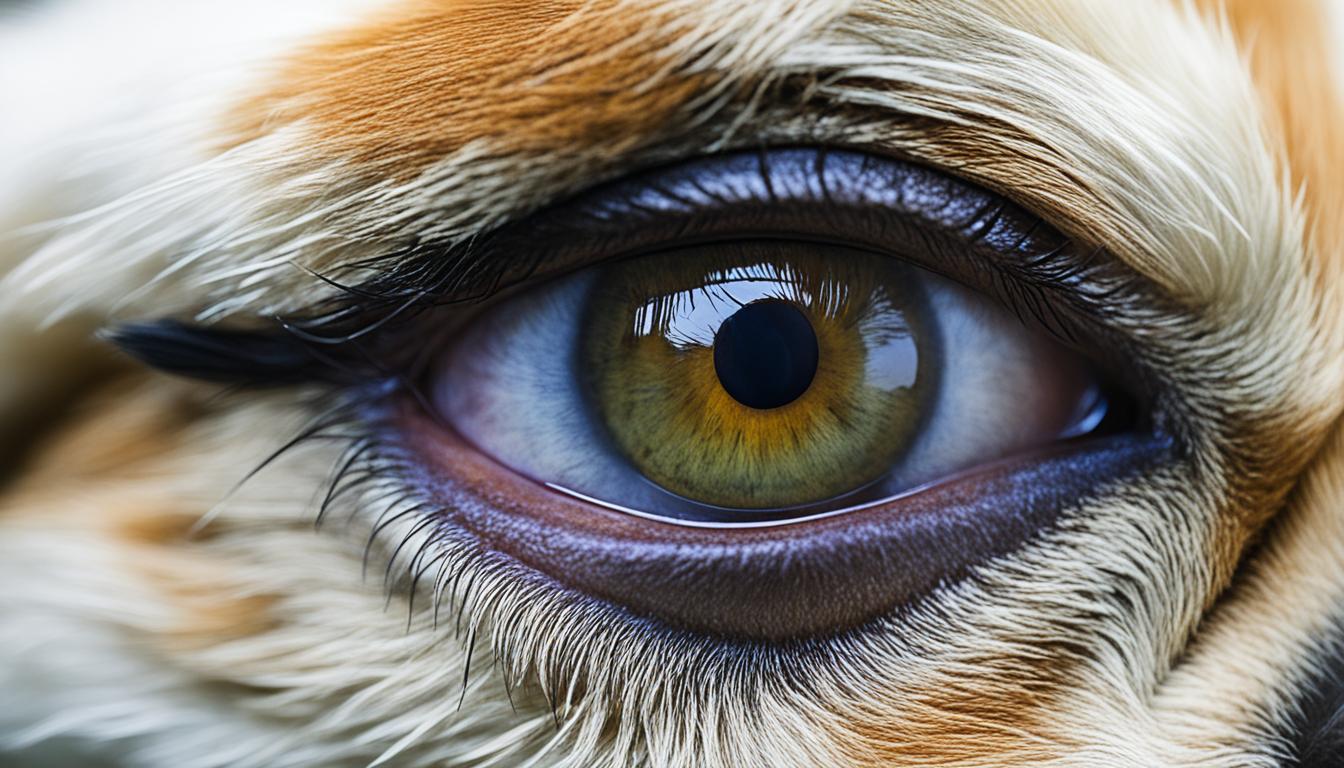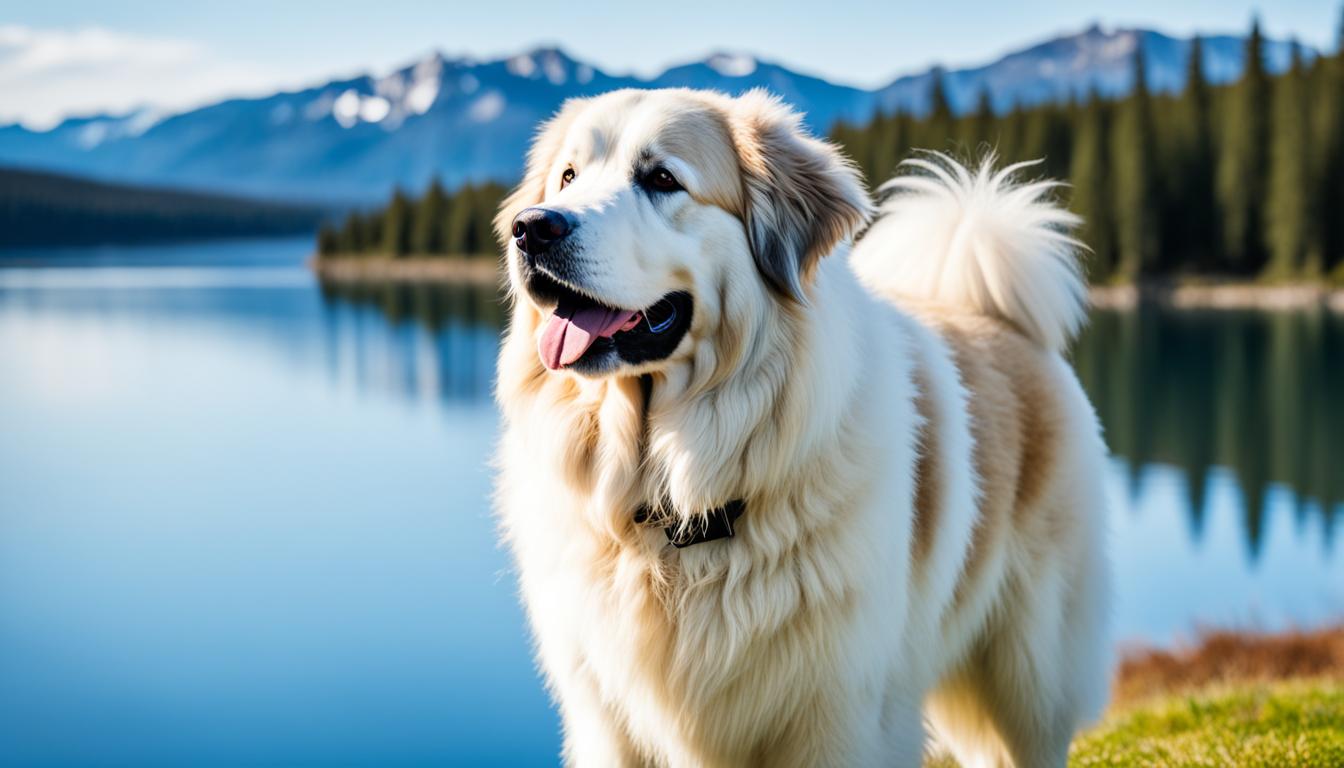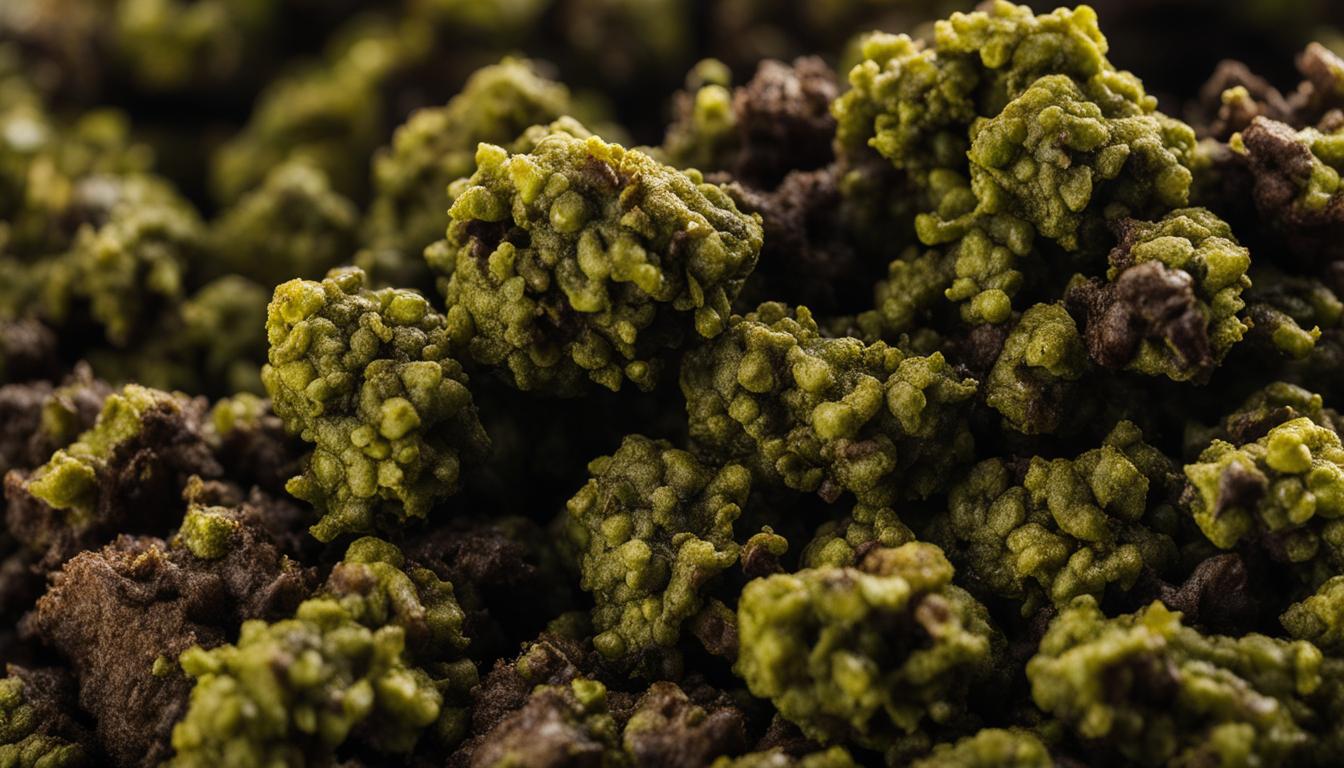Ectropion is a common canine eye condition where the lower eyelid rolls outward or is everted, causing a droopy appearance. This abnormality exposes the delicate conjunctival tissues, leading to conjunctivitis and keratitis. While it can occur in any dog, certain breeds, such as Cocker Spaniels, Saint Bernards, and Bulldogs, are more prone to developing ectropion. Other causes include facial nerve paralysis, hypothyroidism, and injury.
Diagnosing ectropion is done through a physical examination by a veterinarian who can assess the eyelid positioning and identify any underlying conditions. Treatment options for this condition vary depending on its severity. While mild cases can be managed with medical therapy, severe cases may require surgical correction.
- Ectropion is an eye condition in dogs where the lower eyelid rolls outward, causing a droopy appearance.
- Certain breeds are more prone to ectropion, such as Cocker Spaniels, Saint Bernards, and Bulldogs.
- Other causes of ectropion include facial nerve paralysis, hypothyroidism, and injury.
- Diagnosis is made through physical examination, and treatment options range from medical therapy to surgical correction.
Breeds Prone to Ectropion
Certain dog breeds are more prone to ectropion, including Cocker Spaniels, Clumber Spaniels, and Basset Hounds. Dog breeds with ectropion also include Saint Bernards, Bulldogs, and Chow Chows. These breeds have a higher incidence of ectropion, which can be attributed to genetic factors and selective breeding practices. Breed-related ectropion is a common form of this condition in veterinary practice.
Ectropion is a condition that affects the eyelids, causing the lower eyelid to roll outward or become everted. It results in a sagging appearance and can lead to various eye problems. While ectropion can occur in any dog breed, some breeds are more predisposed to developing this condition due to their genetic makeup.
Breed-related ectropion occurs when certain breeds have a higher likelihood of developing ectropion compared to others. This can be influenced by genetic factors that contribute to the anatomy and structure of the eyelids. Breeds with loose facial skin and droopy eyelids are more susceptible to ectropion.
Common Breeds Prone to Ectropion:
- Cocker Spaniels
- Clumber Spaniels
- Basset Hounds
- Saint Bernards
- Bulldogs
- Chow Chows
In addition to the breeds listed above, there may be other breeds that are also susceptible to ectropion. It is important for dog owners to be aware of their breed’s predisposition to this condition and monitor their dog’s eyes for any signs of ectropion.
Symptoms and Diagnosis of Ectropion
Ectropion in dogs can be identified through specific symptoms. Common clinical signs of ectropion include a sagging or outward rolling lower eyelid, thick discharge along the eyelid margin, and redness or inflammation of the eye and conjunctiva. Dogs with ectropion may also exhibit behaviors like rubbing or pawing at the affected eye and show tear staining of the fur beneath the eyes.
Diagnosing ectropion in dogs is typically done through a thorough physical examination by a veterinarian. In some cases, additional tests may be necessary to determine underlying causes or assess the extent of the condition. These tests can include blood and urine tests, corneal staining to evaluate the condition of the cornea, and even muscle or nerve biopsies in more complex cases.
Early identification of ectropion symptoms is crucial to ensure timely and accurate diagnosis. Seeking veterinary attention at the first signs of eye discomfort or abnormality can lead to effective management and treatment of this condition.
Signs of Ectropion:
- Sagging or outward rolling lower eyelid
- Thick discharge along the eyelid margin
- Redness or inflammation of the eye and conjunctiva
- Rubbing or pawing at the eye
- Tear staining of the fur beneath the eyes
Once symptoms are observed, consulting with a veterinarian is essential for a proper diagnosis. The physical examination will allow the veterinarian to thoroughly evaluate the eyelids, look for signs of conjunctivitis or other eye infections, and observe the dog’s behavior for any indication of discomfort or pain.
Additional Diagnostic Procedures:
- Blood and urine tests
- Corneal staining
- Muscle or nerve biopsies
These diagnostic procedures can help determine if there are other underlying causes contributing to the development of ectropion and guide the most appropriate treatment plan.
Treating Mild Ectropion
Mild cases of ectropion in dogs can often be effectively managed with medical therapy. The main goal of treatment is to alleviate symptoms and prevent further complications associated with this eyelid abnormality.
Lubricating Eye Drops and Ointments
One of the primary treatment approaches for mild ectropion involves the use of lubricating eye drops and ointments. These products help to keep the cornea and conjunctiva moisturized, preventing dryness and irritation. By ensuring proper lubrication, the risk of corneal damage and associated conditions can be significantly reduced.
Ophthalmic Antibiotics
In some cases, dogs with mild ectropion may develop corneal ulcers due to their exposed conjunctival tissues. In such situations, ophthalmic antibiotics may be prescribed by the veterinarian. These medications help to prevent or treat bacterial infections that can occur as a result of corneal damage. Regular administration and close monitoring are vital to ensure the effectiveness of antibiotic treatment.
Regular Veterinary Check-ups and Eye Care
“Regular veterinary check-ups and eye care are important for dogs with mild ectropion to monitor the condition and prevent any exacerbation of symptoms.”
It is crucial to schedule regular check-ups with a veterinarian to monitor the progression of ectropion. During these visits, the vet will evaluate the eyelid’s position and assess any changes in the eye’s condition. They may recommend additional treatments or adjust the current therapy based on the dog’s response and overall well-being.
Additionally, proper eye care at home is essential to manage ectropion effectively. This includes gently cleaning the area around the eyes to prevent debris accumulation, avoiding irritants that may further exacerbate the condition, and keeping the dog’s eyes free from excessive tearing.
Comparison of Treatment Approaches for Mild Ectropion
| Treatment | Method | Benefits |
|---|---|---|
| Lubricating Eye Drops and Ointments | Topical application | Prevents corneal dryness, reduces irritation |
| Ophthalmic Antibiotics | Oral or topical administration | Treats or prevents bacterial infections due to corneal damage |
| Regular Veterinary Check-ups and Eye Care | Monitoring and preventive measures | Ensures proper management and timely adjustments of treatment |
Surgical Correction for Severe Ectropion
Severe cases of ectropion in dogs may require surgical correction to restore the normal contour of the eyelid. This procedure, typically performed by a veterinary ophthalmologist, aims to reposition the eyelid properly in relation to the cornea. By shortening and tightening the eyelid, the surgery helps alleviate the symptoms of severe ectropion.
During eyelid surgery for dogs, the veterinarian will carefully adjust the position of the eyelid to prevent outward rolling and exposure of the sensitive conjunctival tissues. The goal is to improve eye function, promote proper tear distribution, and protect the cornea from potential injury or infection.
Post-operative care is crucial to ensure optimal healing and minimize complications. After surgery, the dog’s eye may require frequent monitoring and the use of prescribed medications to manage pain, inflammation, and prevent infection. The veterinarian will provide specific instructions on how to care for the surgical site, administer medications, and schedule follow-up visits for evaluation.
With proper surgical correction and post-operative care, there is a high success rate in addressing severe ectropion in dogs. It is essential to closely follow the veterinarian’s recommendations to promote a smooth recovery and achieve the best possible outcome.
Prognosis and Long-Term Management
The prognosis for ectropion in dogs is generally good, with various treatment options available to manage the condition. The prognosis depends on whether the dog undergoes medical management or surgical correction.
For dogs with mild ectropion, medical treatment can be lifelong to address flare-ups of conjunctivitis and maintain proper eye lubrication. This may involve the use of lubricating eye drops and ointments to prevent corneal drying and the development of corneal ulcers. Regular veterinary check-ups and eye care are crucial in the long-term management of mild cases.
Most dogs with ectropion can lead normal, pain-free lives as long as their condition is appropriately managed. With the right care, dogs with ectropion can enjoy improved eye comfort and quality of life. However, if ectropion is left untreated and corneal scarring occurs, there may be permanent visual deficits.
It is important to note that breeding dogs with severe ectropion requiring surgical correction is not recommended due to the hereditary nature of the condition. Responsible breeding practices can help minimize the risk of passing on ectropion to offspring. Genetic testing and selecting breeding pairs with healthy eye structures can contribute to reducing the incidence of ectropion in future generations of dogs.
Overall, proactive and ongoing care is essential for dogs with ectropion. Regular vet check-ups, attentive eye care, and appropriate medical or surgical intervention can ensure a positive prognosis and a happy, pain-free life for dogs affected by this condition.
Complications and Risks of Ectropion Surgery
Ectropion surgery, like any surgical procedure, carries some risks and potential complications. It is crucial for pet owners to be aware of these possibilities and understand the importance of proper post-operative care.
Potential Complications
While ectropion surgery is generally a safe procedure, there are some potential complications to be aware of:
1. Under-correction of the eyelid: In some cases, the surgical correction may not fully resolve the underlying problem of ectropion. This can result in persistent or recurrent eyelid drooping and may require additional surgical intervention.
2. Overcorrection leading to entropion: Overcorrection occurs when the eyelid is tightened too much, causing it to grow inward. This can lead to irritation and potential damage to the cornea. It is crucial for the surgeon to carefully evaluate and adjust the tension during the surgery to avoid this complication.
3. Self-trauma to the incision site: Dogs are naturally curious and may attempt to scratch or rub their eyes, especially if they’re uncomfortable or in pain during the healing process. It is essential to strictly follow post-operative care instructions and keep the Elizabethan collar on to prevent self-inflicted injuries to the surgical site.
Minimizing Risks
To minimize the risks associated with ectropion surgery, it is crucial to:
1. Choose a skilled veterinary ophthalmologist: Ectropion surgery is a delicate procedure that requires expertise. It’s advisable to seek out a board-certified veterinary ophthalmologist who has significant experience performing eyelid surgeries.
2. Follow post-operative care instructions: Proper post-operative care is essential for a successful recovery. This includes administering medication as prescribed, ensuring proper wound hygiene, and preventing self-inflicted trauma by keeping the Elizabethan collar on as directed by the veterinarian.
3. Attend follow-up appointments: Regular follow-up appointments are crucial to monitor the healing process and address any concerns that may arise. Any signs of infection, swelling, or persistent drooping should be promptly reported to the veterinarian.
Remember, while complications can occur, they are rare, and most dogs who undergo ectropion surgery have a successful outcome with minimal risks. By following the veterinarian’s guidance and providing diligent care, you can help ensure a smooth recovery for your furry friend.
Comparison of Risks and Complications
| Risks and Complications | Description |
|---|---|
| Under-correction of the eyelid | The surgical correction may not fully resolve the underlying problem of ectropion, requiring additional intervention. |
| Overcorrection leading to entropion | The eyelid is tightened too much, causing it to grow inward, potentially leading to irritation and damage to the cornea. |
| Self-trauma to the incision site | The dog may scratch or rub their eyes, leading to self-inflicted injuries to the surgical site if the collar is not worn. |
Importance of Early Detection and Eye Care
Early detection of ectropion in dogs is of paramount importance to ensure timely intervention and effective management. Regular eye care and diligent monitoring of your furry friend’s eyes are essential to catch any signs of redness, irritation, or discomfort that may indicate the presence of ectropion. By being vigilant and proactive, you can promptly seek veterinary attention if any eye-related issues arise, allowing for swift diagnosis and appropriate treatment.
One must understand that early intervention can prevent the development of more serious eye conditions that may potentially threaten your dog’s vision. By addressing ectropion at its onset, you can take necessary measures to preserve the long-term health and well-being of your beloved pet.
Regular eye care for dogs serves as a proactive measure to maintain optimal ocular health. It involves gentle cleaning of the eyes to remove any accumulated debris, regular check-ups with a veterinary ophthalmologist or general practitioner, and ensuring that your dog’s eyes are protected from any potential harm, such as exposure to irritants or excessive sunlight.
Moreover, routine eye care enables professionals to monitor your dog’s eye health over time and detect any abnormalities early on. This can be achieved through regular eye examinations, which may involve tests such as visual inspection, tonometry to measure intraocular pressure, fluorescein staining to assess the integrity of the cornea, and tear production evaluation.
By prioritizing early detection and adopting a proactive approach to eye care, you can be at the forefront of safeguarding your dog’s visual wellbeing. Remember, their eyes are precious, and by investing in their care, you are ensuring a brighter future for your furry companion.
Preventing Ectropion and Breeding Considerations
Preventing ectropion in dogs can be challenging since it is often a result of genetic factors. However, responsible breeding practices can play a crucial role in reducing the incidence of ectropion. Breeders should take careful considerations to avoid breeding dogs with severe ectropion that require surgical correction.
One important step in preventing ectropion is genetic testing. By selecting breeding pairs that have healthy eye structures and no history of ectropion, the risk of passing on the condition to offspring can be minimized. Genetic testing can provide valuable insights into the potential genetic predisposition for ectropion in breeding dogs.
Additionally, breeders should prioritize the overall health and conformation of their breeding dogs. Regular veterinary check-ups and thorough evaluations of the breeding stock can help identify any potential issues, including ectropion, before breeding. This proactive approach ensures that only healthy dogs with sound eye structures are used for breeding purposes.
Furthermore, breeders should be well-versed in the breed standards set forth by reputable kennel clubs and breed organizations. These standards often include guidelines on eye health and structures. By following these standards and breeding practices, breeders can contribute to the overall well-being of the breed and reduce the occurrence of ectropion.
It is important to note that while responsible breeding practices can help minimize the risk of ectropion, there is no guarantee of completely preventing the condition. Genetic factors can be complex, and despite efforts to select breeding pairs carefully, ectropion may still occur in offspring.
By prioritizing responsible breeding practices, including genetic testing, selecting healthy breeding pairs, and following breed standards, breeders can make significant strides in reducing the incidence of ectropion in dogs and promoting overall eye health.
Conclusion
Ectropion, a common eyelid abnormality in dogs, can cause discomfort and lead to various eye conditions if left untreated. Early detection, proper diagnosis, and appropriate treatment are essential for managing ectropion and ensuring a happy and pain-free life for affected dogs.
Medical therapy, such as the use of lubricating eye drops and ointments, can alleviate symptoms and prevent drying of the cornea and conjunctiva. In severe cases, surgical correction performed by a veterinary ophthalmologist can restore the normal contour of the eyelid, reposition it properly, and improve the dog’s quality of life.
Responsible breeding practices and regular veterinary care play pivotal roles in preventing and managing ectropion. Breeding dogs with severe ectropion and selecting breeding pairs that have healthy eye structures can help reduce the incidence of this condition in future generations.
By prioritizing early detection, appropriate treatment, and preventive measures, dog owners can ensure that their furry companions live happy and pain-free lives, free from the discomfort and complications associated with ectropion.
FAQ
What is ectropion in dogs?
Ectropion is an abnormality of the eyelids in dogs where the lower eyelid rolls outward or is everted, causing a droopy appearance.
Which dog breeds are more prone to ectropion?
Certain dog breeds, such as Cocker Spaniels, Clumber Spaniels, Basset Hounds, Saint Bernards, Bulldogs, and Chow Chows, are more prone to ectropion.
What are the symptoms of ectropion in dogs?
The symptoms of ectropion in dogs include a sagging or outward rolling lower eyelid, thick discharge along the eyelid margin, redness or inflammation of the eye and conjunctiva, rubbing or pawing at the eye, and tear staining of the fur beneath the eyes.
How is ectropion diagnosed in dogs?
Ectropion in dogs is usually diagnosed through physical examination, which may involve additional tests for underlying causes, such as blood and urine tests, corneal staining, and muscle or nerve biopsies.
How is mild ectropion in dogs treated?
Mild ectropion in dogs can be treated with medical therapy, including the use of lubricating eye drops and ointments to prevent drying of the cornea and conjunctiva. Ophthalmic antibiotics may be prescribed if corneal ulcers develop.
Is surgery required for severe cases of ectropion in dogs?
Yes, severe cases of ectropion in dogs may require surgical correction. The surgery aims to restore the normal contour of the eyelid and is usually performed by a veterinary ophthalmologist.
What is the prognosis for dogs with ectropion?
The prognosis for dogs with ectropion is generally good. With proper care, most dogs with ectropion can lead normal, pain-free lives. However, if left untreated, corneal scarring may occur, leading to permanent visual deficits.
What are the risks and complications of ectropion surgery in dogs?
Ectropion surgery in dogs carries some risks and potential complications, including under-correction or overcorrection of the eyelid and self-trauma to the incision site. However, these complications are rare, and with proper post-operative care, the risks can be minimized.
Why is early detection and eye care important for dogs with ectropion?
Early detection of ectropion is crucial for timely intervention and management. Regular eye care and monitoring are essential to catch any signs of redness, irritation, or discomfort. Prompt veterinary attention should be sought if any issues arise to prevent the development of more serious eye conditions.
How can ectropion be prevented in dogs?
Preventing ectropion in dogs may be challenging since it is often a result of genetic factors. However, responsible breeding practices and selecting breeding pairs that have healthy eye structures can help minimize the risk of passing on the condition to offspring.







